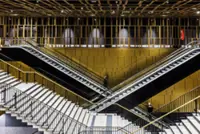An artist’s impression of the Rapid Transit System (RTS) Link in Bukit Chagar in Johor Baru. — Photos: Malaysia Rapid Transit System
IT HAS been more than three years since the groundbreaking of the Rapid Transit Link (RTS) between Johor Baru and Singapore.
So far, 65% of the job has been completed and the project is on schedule to be completed by December 2026.





